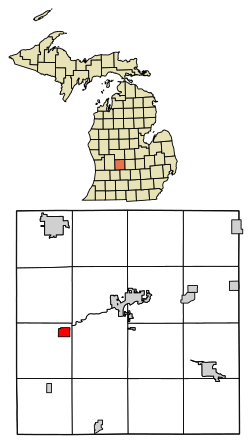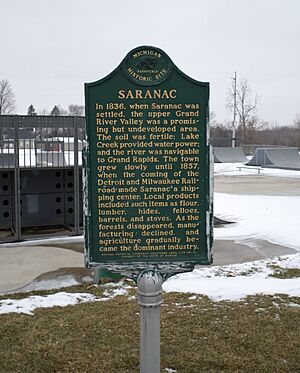Saranac, Michigan facts for kids
Quick facts for kids
Saranac, Michigan
|
|
|---|---|
|
Village
|
|

Location of Saranac, Michigan
|
|
| Country | United States |
| State | Michigan |
| County | Ionia |
| Area | |
| • Total | 1.20 sq mi (3.11 km2) |
| • Land | 1.15 sq mi (2.98 km2) |
| • Water | 0.05 sq mi (0.13 km2) |
| Elevation | 646 ft (197 m) |
| Population
(2020)
|
|
| • Total | 1,376 |
| • Density | 1,196.52/sq mi (461.91/km2) |
| Time zone | UTC-5 (Eastern (EST)) |
| • Summer (DST) | UTC-4 (EDT) |
| ZIP code |
48881
|
| Area code(s) | 616 |
| FIPS code | 26-71660 |
| GNIS feature ID | 0637257 |
Saranac is a village located in Boston Township, Ionia County, in the U.S. state of Michigan. In 2020, about 1,376 people lived there. Saranac is an important center for shops and services that help the farms and communities around it.
Contents
Exploring Saranac's Past
How Saranac Began
Saranac's story started in 1836. A judge from Grand Rapids named Jefferson Morrison bought land where Lake Creek meets the Grand River. He later sold parts of this land to Dwight & Hutchinson from Detroit. Together, they officially started the village.
They quickly named it Saranac. They even held a public sale in Detroit to sell lots of land. However, they did not keep very good records of these sales.
Early Challenges and Growth
Dwight & Hutchinson soon worried because the land buyers were not building anything. So, they gave Cyprian S. Hooker land to build a saw mill. Construction began in 1837 but finished in 1841.
Hooker partnered with Jerry Stocking, a furniture maker. They hoped to become rich in the new village. But they were not successful, and in 1846, they left. Other villagers also moved away, thinking the village would fail.
A New Beginning for the Village
In 1847, a merchant named Ammon Wilson moved to Saranac. He opened a shop on Stocking's old property. Later, he built a warehouse to send wheat to Grand Rapids. This business was very successful.
The village grew around his success. Soon, a tavern and a hotel were built. In 1851, the people who owned the sold-off lots were allowed to rename the township "Boston." This was because of the earlier record-keeping mistakes.
However, by 1859, many people wanted the name changed back to "Saranac." So, it was. In the years that followed, more schools, stores, and churches were built.
The Arrival of the Train
A big moment for Saranac happened in 1857. The first train arrived in the village. This event marked a time of major growth for Saranac.
Saranac's Location and Environment
Where is Saranac Located?
Saranac is a small village. Its total area is about 1.20 square miles (3.11 square kilometers). Most of this area, about 1.15 square miles (2.98 square kilometers), is land. The rest, about 0.05 square miles (0.13 square kilometers), is water.
The Grand River Valley Landscape
The village is in the Grand River Valley. This area is a deep channel formed by glaciers long ago. The Grand River flows right through it.
The land around Saranac has thick forests and large, open farmlands. The forests are mostly found near the Grand River and its low-lying areas, called floodplains and wetlands.
Changes to Wetlands Over Time
Over the years, many wetlands in the area have shrunk. This happened because they were drained or filled in. People did this to create more land for farming.
Even though wetlands are very important for nature, this change is common in Michigan.
Who Lives in Saranac?
| Historical population | |||
|---|---|---|---|
| Census | Pop. | %± | |
| 1860 | 468 | — | |
| 1870 | 724 | 54.7% | |
| 1880 | 877 | 21.1% | |
| 1890 | 790 | −9.9% | |
| 1900 | 768 | −2.8% | |
| 1910 | 845 | 10.0% | |
| 1920 | 750 | −11.2% | |
| 1930 | 729 | −2.8% | |
| 1940 | 849 | 16.5% | |
| 1950 | 885 | 4.2% | |
| 1960 | 1,081 | 22.1% | |
| 1970 | 1,223 | 13.1% | |
| 1980 | 1,421 | 16.2% | |
| 1990 | 1,461 | 2.8% | |
| 2000 | 1,326 | −9.2% | |
| 2010 | 1,325 | −0.1% | |
| 2020 | 1,376 | 3.8% | |
| U.S. Decennial Census | |||
Population Facts from 2010
In 2010, the census counted 1,325 people living in Saranac. There were 573 households and 339 families. The village had about 1,152 people per square mile (445 per square kilometer).
There were 616 homes, with about 536 homes per square mile (207 per square kilometer). Most residents, 97.4%, were White. A small number were African American (0.2%), Native American (0.2%), or Asian (0.4%). About 2.7% of the population was Hispanic or Latino.
Households and Families
About 33.3% of households had children under 18 living there. About 42.2% were married couples. Some households had a female head (12.6%) or a male head (4.4%) without a spouse. About 40.8% were not families.
About 36.5% of all households were single individuals. And 15.9% had someone aged 65 or older living alone. The average household had 2.31 people. The average family had 3.01 people.
Age and Gender in Saranac
The average age in the village was 37.2 years. About 28% of residents were under 18. About 6.8% were between 18 and 24. About 24.2% were from 25 to 44. And 25.8% were from 45 to 64. Finally, 15.1% were 65 years or older.
The village had slightly more females (52.4%) than males (47.6%).
Famous People from Saranac
- J Harlen Bretz, a well-known geologist, grew up in Saranac.
See also
 In Spanish: Saranac para niños
In Spanish: Saranac para niños


